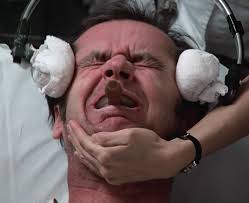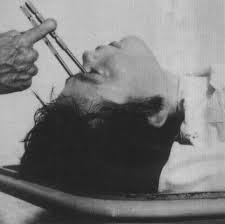Warning: This article contains images depicting fictional ECT and actual lobotomies, which some people may find distressing.
Film directed Milos Forman; Review by Morgan Welsh.
I’ll apologise now if this review takes a slightly rambling tangent, but I did try to stick to the highly acclaimed 1975 film (it won 5 Academy Awards). I first watched One Flew Over the Cuckoo’s Nest during a psychology lesson in sixth form. The film had a profound (and that is an appropriate word) impact on me because of the shocking treatment depicted during the 1963 Oregon mental institute.
 Oregon mental institute where the film was based
Oregon mental institute where the film was based
The film is an adaption of the 1962 book of the same name by Ken Kesey (but apparently only loosly based on the book – Kesey apparently never watched it and hated it). The film is based around the character McMurphy (Jack Nicolson), who initially believes that life in a mental institute will be a lot easier than the prison sentence is serving, so fakes mental illness. He soon realises, however, that life in a mental institute is not as easy as he first thought, especially when he learns that his stay in hospital may be even longer than his prison sentence.
For me, this film has many similarities to the Rosenhan experiment (1973), as the Rosenham experiment shows how difficult it would be to leave an institution if you lied your way in. The experiment used pseudo patients in an attempt to gain admission to psychiatric hospitals. They called for an appointment and feigned auditory hallucinations. Once these sane people were admitted the majority were diagnosed with schizophrenia. They were not allowed to leave, for an average of 19 days, even though they were not suffering from a mental illness at all.
Whether McMurphy faked mental illness or actually was suffering from some condition is open to interpretation. But if he did fake it he greatly underestimated his ability to leave the institution.
McMurphy’s main rival is Nurse Ratched (Louise Fletcher), who uses manipulation, humiliation and a boring daily routine to supress the patients. As McMurphy challenges Nurse Ratched and rallies the other patients to defy her events in the film begin to escalate.
A particularly horrible scene for me is when Electroconvulsive Therapy (ECT) is used as a punishment for McMurphy and two other patients, Cheswick and Chief, after a fight with the staff. It shows how barbaric ECT was back in the 60’s, as the patient is awake, without any muscle relaxant and is held down as the electric current induces a fit.
McMurphy about to receive ECT from the film
Towards the end of the film, things have really intensified the result is a shocking outcome for McMurphy (which I won’t mention here as I don’t want to ruin the ending for those who haven’t watched it!).
This film really made me question how awful mental health care was and understand how much it has improved. After watching the film, I researched the Oregon mental institute, where the film is based, and found out that patients were forced to work 12-hour days to cover the costs of the hospital. 2,500 patients were sterilised from 1918 to 1983, as they were deemed unfit to be parents. Lobotomies were common practice and resulted in the patient becoming calm and compliant, but essentially losing their personality. This procedure severed connections between the frontal lobes and the rest of the brain. It was mainly used to treat depression and schizophrenia, but was also used to control difficult, moody patients.
Lobotomy procedure through the eye sockets
While googling I found an interesting article from the perspective of a patient about life in American psychiatric hospitals in the 60’s. William Carney wrote about his experience of staying in nine different psychiatric hospitals for 40 months. He found there were inhumane conditions such as overcrowding, forced work and regular ECT. He was given powerful doses of antipsychotic drugs to treat schizophrenia, which made him feel like a zombie. Nowadays he mentions how treatment has improved as it uses a more holistic approach with less toxic medication and a greater emphasis on being integrated back into the community.
I really enjoyed having the opportunity to re-watch One Flew Over the Cuckoo’s Nest. And writing this article definitely inspired me to research what life was like in a mental institute in the past. Though films are made to more dramatic than real life, I feel One Flew Over the Cuckoo’s Nest depicts life in a mental institute relatively accurately, in terms of the use of ECT, lobotomies and suppression of the patients using drugs and manipulation. I would highly recommend watching the film, not only from a psychological perspective, but also just for good dramatic entertainment.
For William Carney’s paper see here
The IMDB link for One Flew Over The Cuckcoo’s Nest is here


